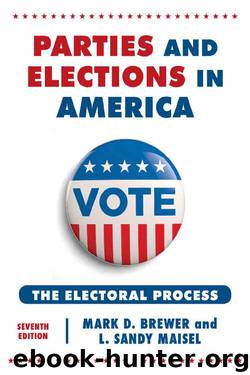Parties and Elections in America: The Electoral Process by Mark D. Brewer & L. Sandy Maisel

Author:Mark D. Brewer & L. Sandy Maisel [Brewer, Mark D.]
Language: eng
Format: epub
Publisher: Rowman & Littlefield Publishers
Published: 2015-10-16T04:00:00+00:00
CRITICAL THINKING QUESTIONS
1. Are so-called “average people” equipped to hold public office?
2. Should local elections be partisan or non-partisan? Why?
3. Do local elections matter?
4. Should all state and local elected offices have term limits?
KEY TERMS
candidate-centered
redistricting
reapportionment
gerrymandering
one person–one vote
direct mail
canvassing
marginal seats
term limits
NOTES
1. Before we proceed any further, we should recognize that this assumption is, in all likelihood, not supportable. Few politicians really understand the process into which they are entering; even experienced politicians make decisions about campaigns in spite of information that would lead a rational person to another conclusion (Hershey 1984; Maisel 1986).
2. Exceptions to this generalization include a politician’s race for office in order to increase name recognition and visibility for a future race, politicians who might be “term limited” out of a seat in another two years and see the chance now, no matter how slim, as better than it will be in the future, and/or a politician’s willingness to run a seemingly futile race in order to ensure that a respectable candidate is fielded. The candidate in the latter instance earns many IOUs from the party.
3. Obviously one key factor is whether one must give up a current office to run for another office. In most cases this is so, but exceptions exist. For example, as noted earlier, five states hold state elections in odd-numbered years and thus terms for state legislature do not expire when congressional elections are held.
4. The candidate is not an incumbent. But incumbents have all faced this problem at some point—when they first sought the office; although now they are in the position of a candidate seeking to stay in the same office. By and large, their campaign tactics were dictated by what worked well the last time.
5. In areas with strong party organizations, party volunteers still carry “sample ballots,” urging supporters to vote for all candidates in their party. This technique is particularly effective in areas dominated by one party or the other, or in areas in which the organization can effectively target households in which their supporters live (Hicks 1998).
6. There is a growing literature on campaign consultants. See, as examples, Thurber and Nelson (2000); Johnson-Cartee and Copeland (1997); Medvic and Lenart (1997); Petracca (1989); Shea (1996); and Sabato (1981).
7. As is always the case with data concerning U.S. Senate elections, it is necessary to interpret percentages with great caution. Although percentaging among 435 House elections makes good sense, presenting percentage data when the total number involved is generally less than thirty can lead to misinterpretation. The number of incumbent senators seeking reelection in any campaign is small enough that analysis of individual races is often most appropriate.
8. The caveat that increased competition is not likely in strong one-party areas needs to be added, though it is rarely raised by those arguing for term limits.
9. It is worth noting that the momentum for term limits seems to have abated. After they captured majority status in the Congress in 1994, the Republicans attempted to pass a constitutional amendment mandating term limits, as they had promised in the Contract with America. That amendment did not pass; it was opposed by a significant number of Republicans.
Download
This site does not store any files on its server. We only index and link to content provided by other sites. Please contact the content providers to delete copyright contents if any and email us, we'll remove relevant links or contents immediately.
The Secret History by Donna Tartt(18939)
The Social Justice Warrior Handbook by Lisa De Pasquale(12164)
Thirteen Reasons Why by Jay Asher(8837)
This Is How You Lose Her by Junot Diaz(6830)
Weapons of Math Destruction by Cathy O'Neil(6206)
Zero to One by Peter Thiel(5729)
Beartown by Fredrik Backman(5668)
The Myth of the Strong Leader by Archie Brown(5456)
The Fire Next Time by James Baldwin(5379)
How Democracies Die by Steven Levitsky & Daniel Ziblatt(5168)
Promise Me, Dad by Joe Biden(5111)
Stone's Rules by Roger Stone(5051)
A Higher Loyalty: Truth, Lies, and Leadership by James Comey(4904)
100 Deadly Skills by Clint Emerson(4876)
Rise and Kill First by Ronen Bergman(4739)
Secrecy World by Jake Bernstein(4698)
The David Icke Guide to the Global Conspiracy (and how to end it) by David Icke(4654)
The Farm by Tom Rob Smith(4464)
The Doomsday Machine by Daniel Ellsberg(4446)
